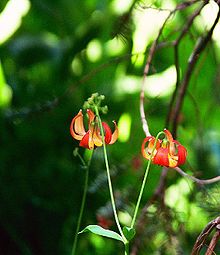Caribou Wilderness
The Caribou Wilderness comprises 20,546 acres (83.15 km2)[1] and is adjacent to the east side of Lassen Volcanic National Park.
The terrain is a volcanic plateau with 75% covered by water and conifer forests and the remainder being barren rock such as cliff faces, talus slopes and cinder cones.
Most of this area has been preserved since 1932 which makes the Caribou Wilderness one of the few remaining pristine forests of the California Cascade region.
There are 23 named lakes, innumerable unnamed ponds and tarns, cinder cones and volcanic buttes within the wilderness.
The Forest Service encourages the practice of Leave No Trace principles of outdoor travel to minimize human impact on the environment.
Black-tailed deer and black bears along with squirrels, chipmunks, and the protected (from hunting) pine marten live here.
As the sanitary agents of the forest that consume dead organic matter, fungi spread on the floor of a conifer area.
Along some trails in the Caribou, hikers will see a timber-destroying (causes brown rot) [6] pore fungi called the red-belt fomes.
There are no man-made structures or conveniences, although occasionally evidence of prior land use before the wilderness designation, such as old fences and tree blazes are found.
Off-trail travel is possible but challenging due to many large fallen trees and brush between wet meadows which is the nature of a wilderness area.


